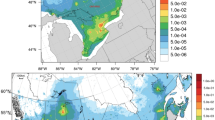Abstract
A special exposure system was used for the inhalation of nickel oxide (NiO) aerosol by Wistar male rats. The median aerodynamic diameter and the geometric standard deviation were 1.2 μm and 2.2, respectively. A histopathological study of the rats was performed immediately, and at intervals of 12 and 20 mo after a 1-mo expsoure to NiO. Electron microscopy showed that localization of NiO particles was restricted to the lungs and that each particle had been engulfed by the alveolar macrophages. Type II pneumocytes and nonciliated bronchiolar epithelial cells (Clara cells), as well as numerous tubular myelin (surfactant) in the alveoli were prominent. In rats dissected after 12 mo, clusters of NiO particles were still present within the terminal bronchioli, alveolar walls, and lysosomes of the alveolar macrophages. Pools of tubular myelin were observed in the peribron-chial lymphatics. The Clara cells, which project into the lumen of bronchioli, showed active secretion and were filled with smooth en-doplasmic reticulum (SER) in the apical cytoplasm. In the experimental group sacrificed after 20 mo, one rat had papillary adenocarcinoma and two rats showed adenomatosis in the peripheral portion of the lung, but none in the upper respiratory tract.
Similar content being viewed by others
References
C. Jarstrand, M. Lundborg, A. Wiernick, and P. Camner,Toxicology 11, 353 (1978).
M. C. Bruce, P. Camner, and T. Curstedt, inPulmonary Toxicology of Respirable Particles, C. L. Sanders et al., eds., Technical Information Center, Washington, DC, 1980, pp. 357–366.
I. Tanaka, H. Hayashi, A. Horie, Y. Kodama, T. Akiyama, and K. Tsuchiya,J. UOEH 4, 441 (1982).
Y. Kodama, S. Ishimatsu, K. Matsuno, I. Tanaka, and K. Tsuchiya,Biol. Trace Element Res. 7, 1 (1985).
A. Johansson, P. Camner, and B. Robertson,Environ, Res,25, 391 (1981).
A. Johansson and P. Camner, inPulmonary Toxicology of Respirable Particles, C. L. Sanders et al., eds., Technical Information Center, Washington, DC, 1980, pp. 311–324.
A. P. Wehner, R. H. Busch, R. J. Olson, and D. K. Craig,Am. Ind. Hyg. Assoc. J. 36, 801 (1975).
Y. Kikkawa and T. Manabe,Anat. Rec. 190, 627 (1978).
T. Manabe,J. infrastructure Res. 69, 86 (1979).
A. H. Niden,Science 158, 1323 (1967).
W. C. Hueper,Arch, Path. 65, 600 (1958).
T. W. Sunderman and A. J. Donnelly,Amer. J. Path. 46, 1027 (1965).
A. D. Ottolenghi, J. K. Haseman, W. W. Payne, H. L. Falk, and H. N. MacFarland,J. Natl. Cancer Inst. 54, 1165 (1974).
A. FurstEnviron. Health Persp. 40, 83 (1981).
Author information
Authors and Affiliations
Rights and permissions
About this article
Cite this article
Horie, A., Haratake, J., Tanaka, I. et al. Electron microscopical findings with special reference to cancer in rats caused by inhalation of nickel oxide. Biol Trace Elem Res 7, 223–239 (1985). https://doi.org/10.1007/BF02989248
Received:
Accepted:
Issue Date:
DOI: https://doi.org/10.1007/BF02989248




